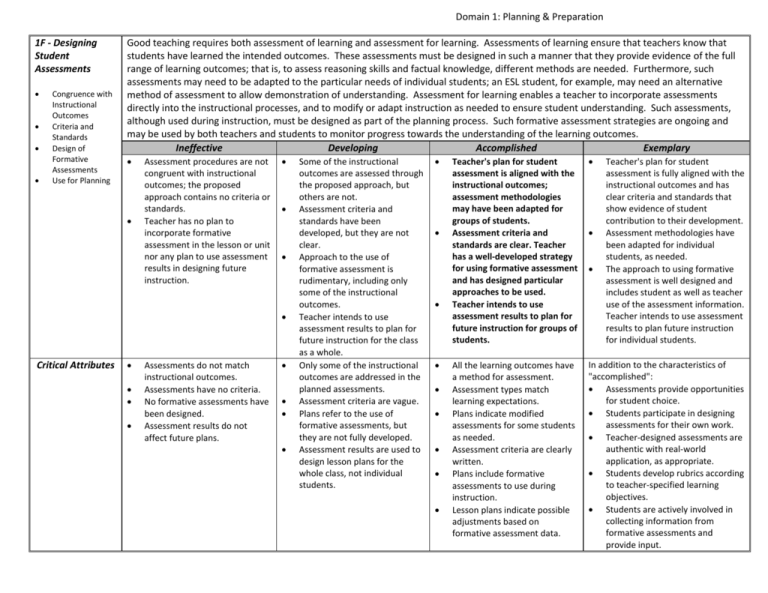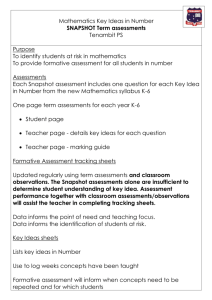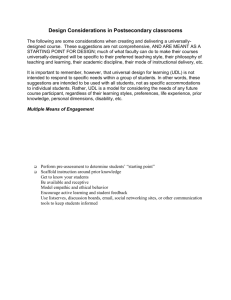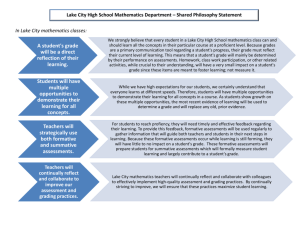1F Designing Student Assessments
advertisement

Domain 1: Planning & Preparation 1F - Designing Student Assessments Congruence with Instructional Outcomes Criteria and Standards Design of Formative Assessments Use for Planning Good teaching requires both assessment of learning and assessment for learning. Assessments of learning ensure that teachers know that students have learned the intended outcomes. These assessments must be designed in such a manner that they provide evidence of the full range of learning outcomes; that is, to assess reasoning skills and factual knowledge, different methods are needed. Furthermore, such assessments may need to be adapted to the particular needs of individual students; an ESL student, for example, may need an alternative method of assessment to allow demonstration of understanding. Assessment for learning enables a teacher to incorporate assessments directly into the instructional processes, and to modify or adapt instruction as needed to ensure student understanding. Such assessments, although used during instruction, must be designed as part of the planning process. Such formative assessment strategies are ongoing and may be used by both teachers and students to monitor progress towards the understanding of the learning outcomes. Ineffective Developing Accomplished Exemplary Assessment procedures are not congruent with instructional outcomes; the proposed approach contains no criteria or standards. Teacher has no plan to incorporate formative assessment in the lesson or unit nor any plan to use assessment results in designing future instruction. Critical Attributes Assessments do not match instructional outcomes. Assessments have no criteria. No formative assessments have been designed. Assessment results do not affect future plans. Some of the instructional outcomes are assessed through the proposed approach, but others are not. Assessment criteria and standards have been developed, but they are not clear. Approach to the use of formative assessment is rudimentary, including only some of the instructional outcomes. Teacher intends to use assessment results to plan for future instruction for the class as a whole. Only some of the instructional outcomes are addressed in the planned assessments. Assessment criteria are vague. Plans refer to the use of formative assessments, but they are not fully developed. Assessment results are used to design lesson plans for the whole class, not individual students. Teacher's plan for student assessment is aligned with the instructional outcomes; assessment methodologies may have been adapted for groups of students. Assessment criteria and standards are clear. Teacher has a well-developed strategy for using formative assessment and has designed particular approaches to be used. Teacher intends to use assessment results to plan for future instruction for groups of students. All the learning outcomes have a method for assessment. Assessment types match learning expectations. Plans indicate modified assessments for some students as needed. Assessment criteria are clearly written. Plans include formative assessments to use during instruction. Lesson plans indicate possible adjustments based on formative assessment data. In addition to the characteristics of "accomplished": Assessments provide opportunities for student choice. Students participate in designing assessments for their own work. Teacher-designed assessments are authentic with real-world application, as appropriate. Students develop rubrics according to teacher-specified learning objectives. Students are actively involved in collecting information from formative assessments and provide input. Teacher's plan for student assessment is fully aligned with the instructional outcomes and has clear criteria and standards that show evidence of student contribution to their development. Assessment methodologies have been adapted for individual students, as needed. The approach to using formative assessment is well designed and includes student as well as teacher use of the assessment information. Teacher intends to use assessment results to plan future instruction for individual students. Domain 1: Planning & Preparation Possible Examples The teacher marks papers on the foundation of the U.S. constitution on the basis of grammar and punctuation; for every mistake, the grade drops from an A to a B, a B to a C, etc. After the students present their research on globalization, the teacher tells them their letter grade. When students ask how he has arrived at the grade, he responds, "After all these years in education, I just know what grade to give." The teacher says, "What's the difference between formative assessment and the test I give at the end of the unit?" The teacher says, "The district gave me this entire curriculum to teach, so I just have to keep moving." The district goal for the Europe unit is for students to understand geopolitical relationships. The teacher plans to have the students memorize all the country capitals and rivers. The teacher's students receive their tests back; each one is simply marked with a letter grade at the top. The plan indicates that the teacher will pause to "check for understanding" but without a clear indication of how that is to be done. A student says, "If half the class passed the test, why are we all reviewing the material again?" Mr. K knows that his students will write a persuasive essay on the state assessment; he plans to have them write a variety of persuasive essays as preparation. Ms. M has worked on a writing rubric for her research assessment; she has drawn on multiple sources to be sure the levels of expectation are clearly defined. Mr. C creates a short questionnaire to distribute to his students at the end of class; on the basis of their responses, he will organize them into different groups during the next lesson's activities. Based on the previous morning's formative assessment, Ms. D plans to have 5 students to work on a more challenging project while she works with 6 other students to reinforce the concept. To teach persuasive writing, Ms. H plans to have her class research and write to the principal on an issue that is important to the students; the use of cell phones in class. Mr. J's students will write a rubric for their final project on the benefits of solar energy; Mr. J has shown them several sample rubrics, and they will refer to those as they create a rubric of their own. After the lesson Mr. L asks students to rate their understanding on a scale of 1 to 5; the students know that their rating will indicate their activity for the next lesson. Mrs. T has developed a routine for her class: students know that if they are struggling with a math concept, they will sit in a small group with her during workshop time.







